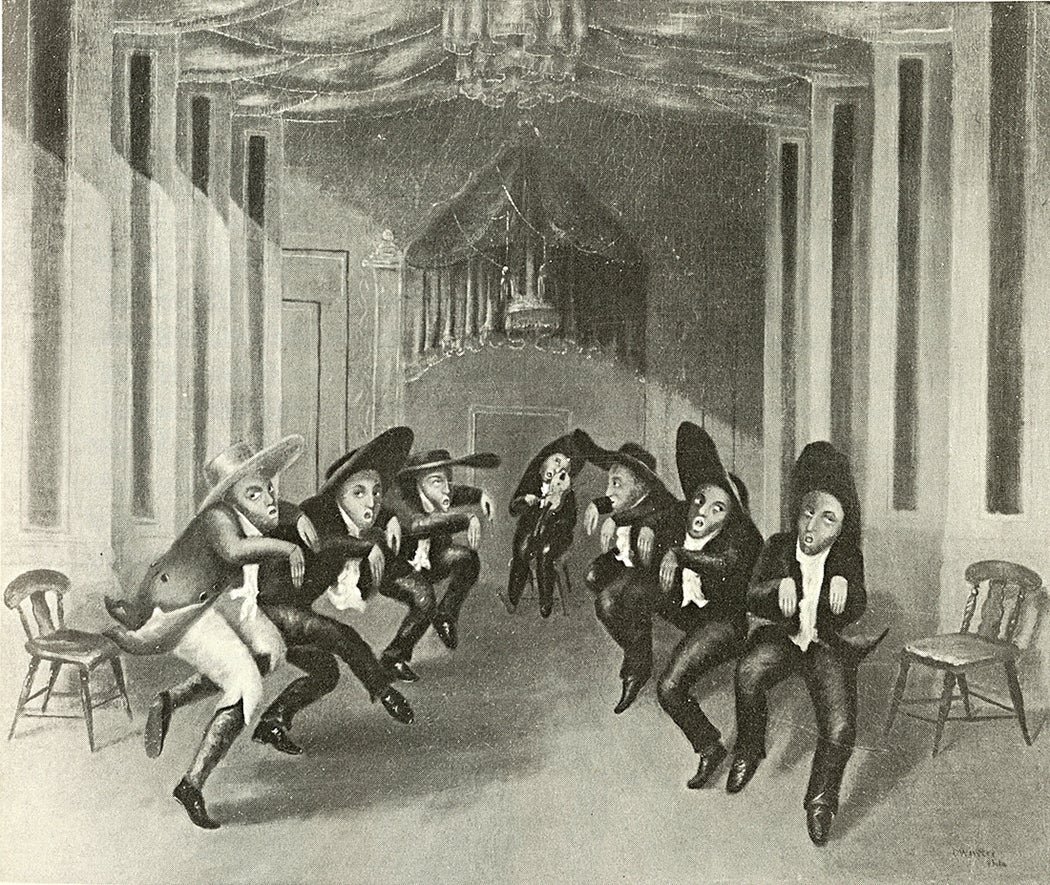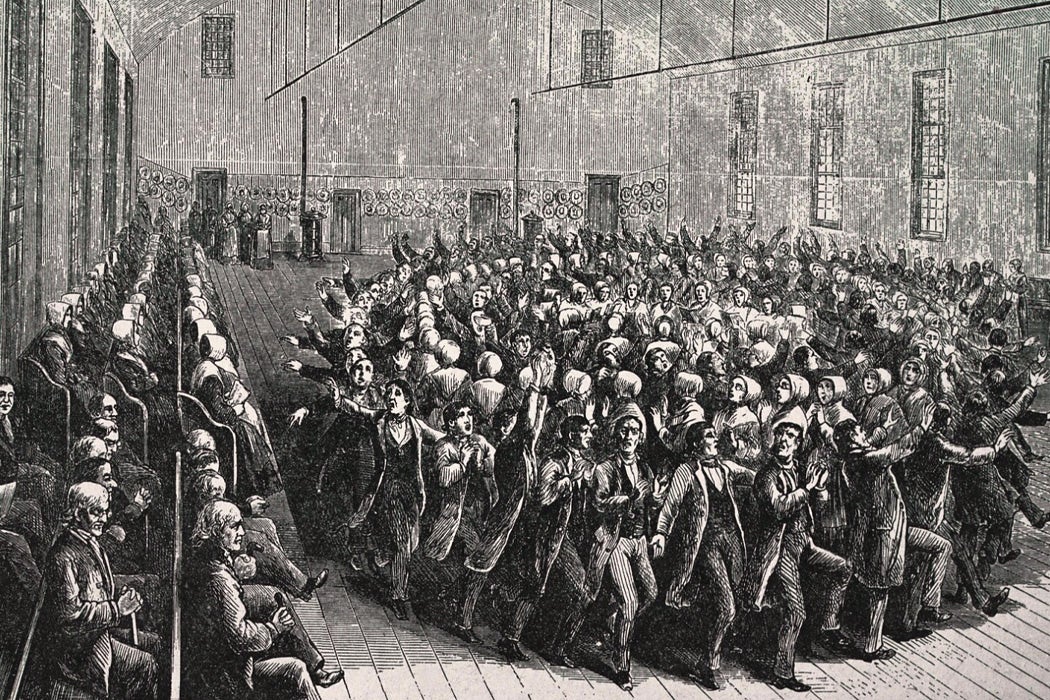This article is based on, though a different version of, the first chapter, “Shake It Off: The Physiopolitics of Shaker Dance, 1774-1856,” of Beside You in Time: Sense Methods and Queer Sociabilities in the American Nineteenth Century, forthcoming on August 30, 2019, from Duke University Press.
We tend to think of the Shakers, when we think of them at all, as gentle people, removed from this world—notable for their celibacy, old-fashioned costumes, and beautiful artisanal furniture.
We don’t really consider them political, except maybe as vaguely pacifist. Their radical roots in the Second Great Awakening, a religious revival in which the body was understood to receive the spirit and manifest grace in spontaneous action, have been mostly forgotten. We do, however, tend to remember that Shakers sang and danced in their Sabbath services. In fact, their name originally comes from the insult “Shaking Quakers,” which mocked their use of their bodies in worship.
Weekly Newsletter
The earliest Shakers, who arrived in the United States in 1774 with their early leader Ann Lee, did not beget children. Instead, they recruited people into their sect, holding public worship ceremonies in which onlookers were invited to participate by dancing and singing. Eighteenth- and nineteenth-century commentators were, in general, scandalized by this method of bringing people into the fold. In short, they stigmatized the Shakers.
Unorthodox Rhythms
Apostates who had left the Shakers—and appalled visitors to their worship sessions—seized on the irregular harmonies of Shaker song and the individualistic contortions of Shaker dancers. In the earliest anti-Shaker pamphlet, written in 1781, apostate Valentine Rathbun describes their tuneless singing and seemingly random dancing:
It is impossible to point out any exact form, for they vary and differ and seldom act the same form exactly over again. They chuse to do so, to be singular, lest, as they say, they should be connected with Babylon.
Other writers describe Shakers whirling, collapsing, or jerking around. Or they describe Ann Lee as a sexual sorceress: one anonymous writer of 1795 portrays her seductively stroking the arms and chests of audience members, drawing them into the dance with bewitching songs and chants.
These witnesses to Shaker worship seemed most concerned with the way Shaker songs did not conform to European harmonies, and with how their dances refused the couple-pairings that formed the nucleus of European-American folk dance.
Shaker dance both embodied and performed a gender-egalitarian community, one whose primary method of reproduction was not sexual. But their worship practices were reviled as both promiscuous and racially aberrant—despite the Shakers’ predominantly Anglo-American heritage.
Anti-Shaker writings of the eighteenth and early nineteenth centuries describe Shaker dance as savage and primitive, words that had been used to describe Native Americans from colonial conquest onwards. But what Shakers had in common with Native Americans, of course, was less their song and dance than their refusal of the heterosexual nuclear family.
While Shakers practiced celibacy, using recruitment and eventually adoption to expand their numbers, many Native American peoples practiced communal living and polygyny—as well as adoption. In short, the rhythmic and harmonic irregularities that anti-Shaker writers found so repugnant were figures for the Shakers’ greater sin: defying the marital-reproductive ideal.
Good and Bad Religion
This reaction to the Shakers is illustrative of the way in which religious activities get divided into “good” and “bad.” “Good religion” generally consists of beliefs or world-views rather than practices, and “bad religion” is understood in terms of activities that are racially and sexually suspect—even when they are practiced by predominantly white populations.

Beliefs are understood to come slowly and with deliberation, while physical manifestations of spiritual experience are understood to be impulsive and irrational. In this sense, religions have tempos or rhythms, and those involved in Shaker worship were particularly threatening because they were seen as promiscuous, primitive, and enslaving. These metaphors, in turn, figured Shakers as implicitly Native American or black. This is in part because their kinship practices did not accord with the marital-reproductive ideas of Anglo-America, and in part because these populations had different rhythmic and harmonic practices than people of European descent. The epithets and caricatures damning the Shaker dance, especially, show us how something as seemingly apolitical and natural as timing has racial and sexual implications.
Dance Reform
Not very long after arriving in the United States, in response to the objections of early republican writers, the Shakers reformed their songs and dances. After the death of Ann Lee, in 1784, elder Joseph Meacham introduced a series of rules for communal living and a new set of dances. In these “laboring” dances, as they were called, men and women moved in tandem rather than individually, in long rows and circles, separated by gender. They did not touch one another or separate off into pairs. Rather than whirling and jerking, they shuffled and skipped.

But Meacham’s efforts at reform did not garner the Shakers praise for their orderly ways. Rather, outsiders’ rhetoric about the Shakers began to focus on their monotony, sameness, and enslavement to pattern. Thus, the terms rather than the degree of stigma changed: dancing in orderly fashion to a common rhythm, Shakers were equated with slaves, another population whose gender norms, household structures, and lack of access to marriage marked them as anathema to European Americans. In fact, one researcher has suggested that the minstrel song “Jump Jim Crow” may be based on a Shaker song and dance, implying that, by the mid-nineteenth century, slaves and Shakers were connected. As the anti-Shaker writer Christopher Clark wrote in 1812, “It is easier to gain white Negroes in America, to work, and dance all their days, than obtain money to purchase black ones.”
By describing Shakers as in thrall to monotonous rhythm, anti-Shaker writers also figured them as a people outside of time and history, much the way Africans have been cast by writers at least as far back as Hegel as a people without a past or a future. This is especially apparent in the anti-Shaker plot of the American author Catharine Maria Sedgwick’s 1824 novel Redwood, in which a female character describes her captivity in a Shaker community: “[T]o what purpose is time measured here? There is no pleasure to come—there is none past that I dare to remember.” Here, it is as if the heterosexual romance denied to her could make time happen, prompting history to move forward.
Lessons from the Shakers
What can we learn from the failure of the Shakers, a predominantly Anglo-American sect, to achieve “peak whiteness” in their own historical moment? Arguably, it took the death of most of the Shakers, whose population has dwindled to a mere handful, and their transformation into a style of home furnishing, to grant them status as exemplary white people. While they were alive and prosperous, they were racialized because of their rhythmic and bodily activities. The communitarian and gender-equal ethos these represented were deeply threatening to a nation for which the marriage bond was understood as an allegory for consensual, egalitarian citizenship.

These sexually aberrant citizens living in the midst of a marital nation were not just a problem in terms of gender and sexuality: the stigmas around them show us how, in the United States, religious difference, sexual dissidence, and rhythmic dissonance intertwined in outsider figures. As Peter Coviello argues in his forthcoming book, Make Yourselves Gods: Mormons and the Unfinished Business of American Secularism, populations who practiced and professed “bad” faith—whose communion with the divine was articulated through and with the body—simply could not count as white, even if they were technically Protestant. Conversely, anti-Shaker rhetoric helped whiteness accrue qualities that counted as properly modern, as a form of “good” faith that looked almost secular: Beliefs and doctrines, rather than physical demonstrations of spirituality. Anti-Shakers sought to set a tempo for collective activity that was neither too individualistic and irregular, nor too massified and patterned.
The Shakers may have been the United States’s first “off-white” people, against whom normative whiteness could emerge. The fact that the stigmas against them looked like arguments against improper religious beliefs and practices should give us pause today. Instead of Shakers, Muslims and other religious minorities are cast as outsiders to an “America” that supposedly grants freedom of religion. Racism and sexual stigma lurk just below the surface of what look like objections to a religion—objections to, for instance, styles of liturgical song and dance.







